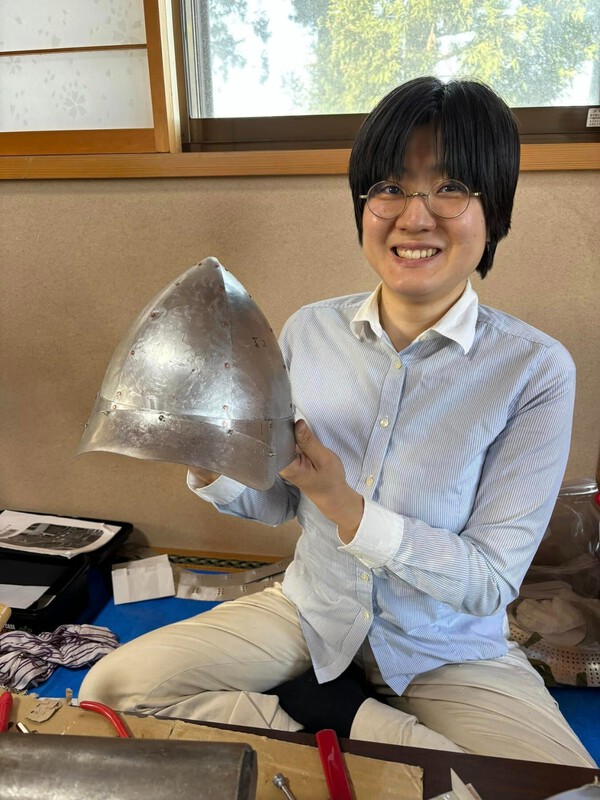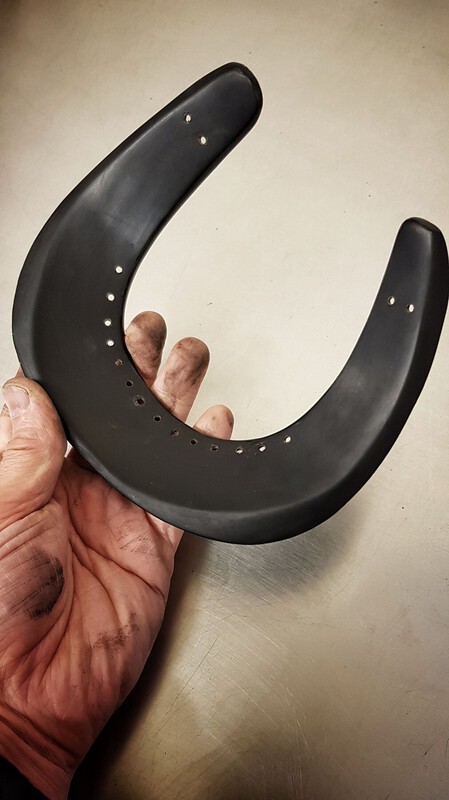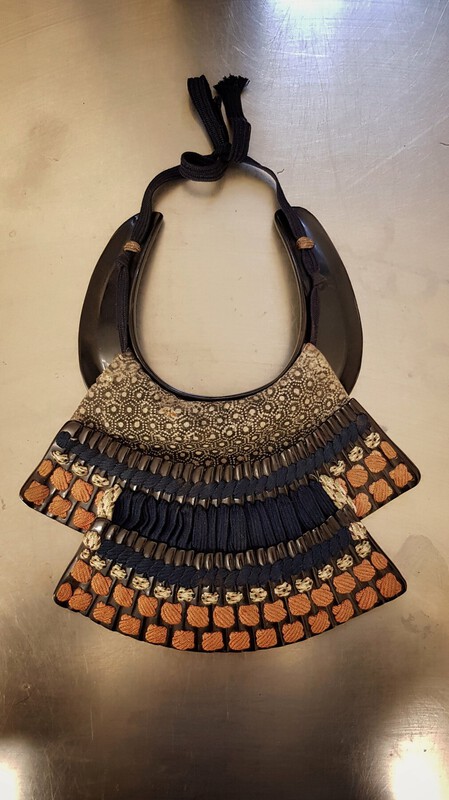-
Posts
46 -
Joined
-
Last visited
Content Type
Profiles
Forums
Events
Store
Downloads
Gallery
Everything posted by Samurai Art
-
A friend of mine, who’s a head doctor, mentioned that he had a visit from someone who claimed that 30 other head doctors had labelled him a narcissist, yet he was sure he wasn’t one. Isn’t repeating the same behaviour repeatedly and expecting different results considered a form of insanity? That's how I feel about this item. It's been posted everywhere on social media, asking the same questions and getting the same answers. The item itself is a rough, odd kote that doesn’t match the description provided. The text, written in the Meiji period, doesn’t align with the actual piece. There are visible signs of it being mounted and remounted—glue marks and rough edges suggest the associated statement and mon about it doesn’t hold up. A sode is not a kote; no mon is on the sleeve either. This piece seems like nothing more than a tourist trap with no real historical value. “Owned by a Shogun?” Seriously? Gethin, I would love you to own a treasure owned by a Muromachi Shogun, but I feel this is not it.
-
This situation is truly shocking, but it’s encouraging to see that Catawiki has taken some action. Personally, I’m not a fan of Catawiki. Their so-called "expert reviews" offer little to no real protection, as their expertise in many areas seems questionable at best. The platform is riddled with listings featuring reproductions, poorly restored items, or blatantly misdescribed pieces. Buyers should exercise extreme caution. Regarding Patrice, I’ve spoken to him several times. Despite what our resident troll often posts about him, I’ve found him to be a kind person. He explained to me that his profile is sometimes used by other administrators on the platform. That said, he has had ample opportunities to distance himself from these issues but hasn’t chosen to do so. As for the forgery of papers and the sword, this is an egregious act of fraud. However, it’s worth considering that the seller might have acquired the item in good faith from another source. Unless there is concrete evidence that it was purchased directly from the Samurai Museum, we should be cautious about assigning blame prematurely. If the latter is proven, then avoiding this seller is the only sensible course of action.
-

Sotheby's Art of Japan Sale
Samurai Art replied to Bryce's topic in Auctions and Online Sales or Sellers
Maybe because the department head is the chairman of Asian Art in London, as are some of their staff directors. They hold a very nice party at the V&A. -

Birmingham Arms Fair - sword descriptions
Samurai Art replied to Matsunoki's topic in Swords and Edged Weapons
PM sent -

Birmingham Arms Fair - sword descriptions
Samurai Art replied to Matsunoki's topic in Swords and Edged Weapons
Hello Colin. I look forward to seeing you there and perhaps taking some items home. Best regards David Thatcher -
Katchu Pillow Fight Mode: I have no interest in getting involved in a urushi dispute. I'm retired and don't have the time for such trivial matters. For clarity, Miura Anjin was the name given to the English pilot William Adams, also known as John Blackthorn, in the novel Shōgun. Regarding other points, tetsu (sabi-ji) urushi nuri refers to a russet iron texture applied to armour. Sabi nuri (錆漆) is a term lacquerers use for filler layers. Andy has had an issue with me since his late teacher claimed I was more skilled than his student. Mancabelli wrote the previous rant. I know how he writes. I will only say this: post your work for all to see. Anyone can boast about their skills, but a photo speaks louder than a thousand words.
-
Samurai and lower-ranked warriors who could not afford armour were loaned it. In the case of Hatamoto samurai, armour might also have been loaned to reflect their rank and ensure uniform appearance. These okashi could range from the highest level of craftsmanship to the most basic. During the Warring States period, and especially from the late Muromachi to the Edo period, armour was designed for practical use. It was constructed to be identifiable from a distance. However, after the Tokugawa unified Japan and war became rare, armour became more decorative, with details meant to be appreciated up close. Armour continued to be used for ceremonial purposes until the late Edo period, when concerns about an American invasion again led to the production of battle-ready armour. During the Warring States period and up to the siege of Osaka, armour needed to be maintained and produced quickly. Consequently, the urushi layers were often thinner. This type of lacquering was sufficient when maintained properly. However, after the samurai class was abolished, there was no longer a need to own armour or pay for its high maintenance costs. Armour was stored away, often repurposed, merged with other pieces, turned into tourist items, or exported. The term ubu is often misused to describe badly damaged items. While an item's condition might be "as found," it does not reflect its original state. The main issue with the lower layers of urushi is that they are not waterproof. As a result, moisture enters through the odoshi-no-ana (the holes for lacing), the joints between plates on the inside, and from chips. This moisture spreads, causing rust, which eventually delaminates the upper urushi layers. Cracks appear, and pieces fall off. The silk also degrades and turns to dust after 80-100 years. So, the bad condition is caused by poor storage and handling and lack of maintenance.
-
Yahoo is blocked for many. This is what he sent you a link to: Yojimbo, aka Simon, is an incorrigible troll notorious for being one of the most unpleasant individuals on this forum. He consistently demeans everyone and everything while peddling subpar products within the sales section. The best course of action is to completely ignore him. Years ago, in Japan, I acquired a worn Momonari kabuto from the Momoyama period. Despite its weathered appearance, it boasts an outstanding shape. It sits proudly in my collection next to an armour once owned by a lord. This is the beauty of armour: regardless of its condition, if you cherish it, that's all that matters. Who cares what anyone else thinks?
-
Piers, As said above, try to obtain a certificate. German Customs are strict about dealing with import/export procedures, which are changing globally as we move towards a digital system. Also, antiques are usually imported at a reduced tax rate, so the onus is now on the sender to prove the claim. I sent several shipments in, and each one had to be accompanied by a certificate. Several professional dealers are now using my KNKBSK service to overcome such problems with international shipping. https://www.Japanese....com/certification/; however, this service is unavailable to non-trade members, so the buyers should ask the person they purchased it from to produce the paperwork. Play the game correctly, and everything is hunky dory.
-
Items over 200,000 yen will invite a Customs Inspection. If possible, obtain a certificate of age from the dealer. At NRT, they will not know what is old, and you risk missing your flight. HS Code 97061000 Description: Antique Katchu is over 150 years old. Iron Country of origin: Japan Better to ship: You won't pay any import duty into the USA, but some states will charge you a 5% tax depending on what value you declare. DHL provide the best service, after that use EMS. Most hitsu get broken in transit. Happy hunting!
-
Trevor, I can tell you this: Not a single katchushi in Japan that I have met can lacquer to what would be deemed an acceptable standard. They do not have the skills to finish the surface. My son is currently learning and I don't want to share any of the armour mixtures or techniques I have learned or developed in order to safeguard his future from a commercial point of view. I learned urushi from a Japanese teacher, and you can study it remotely. There are several good lacquerers in the UK, including Mike Hickman Smith and Clive Hallam (Ford's brother). We are primarily self-taught but have improved over the years by taking instruction. Mixing sabi-urushi is easy and will dry in the air; no furo is required. Please try it and buy some materials from Watanabe Shoten, but please do not attempt to lacquer real armour. Rawhide is a bugger to work with; it has to be dried for at least three years prior; otherwise, it warps and traps in moisture. good luck and all the best with your adventure!
-
I am a member of this board. The mixture is called sabi-urushi nuri, not kokuso, as previously mentioned. It consists of flour, sawdust, or hemp strands. Sabi is made with water and a dried volcanic clay called tonoko. As a retired professional restorer, I cannot delve deeply into the restoration process. I have no interest in educating the three katchushi posers in this group who wish to learn the process to improve their monstrous works. For the newbies, I cannot recommend anything in the same way asking about sword polishing would be received. There are no books on the subject; to learn, you must study metalwork and how to apply urushi yourself. Studying in Japan should allow you to find a teacher like Nishioka or toyoda sensei, which is the only route in my opinion.
-

Swords that I’m taking to Birmingham
Samurai Art replied to Matsunoki's topic in Swords and Edged Weapons
Colin, it was a pleasure to meet you today. You had some really nice items to offer. best regards David -
I have always had a fondness for the Birmingham Arms Fair. It's where I started as a dealer. I had a table that I extended to members of the esteemed Token Society, allowing them to display their items for free. If they sold anything, I requested a small contribution for the table. After the Northern Token closed its table, I took it over with two members (as I was permitted to be a member back then), and we shared the rent to maintain a social gathering point for token and other collectors. It was an excellent way to raise awareness of the society and encourage new memberships to be taken. As my stock items increased in quality and price, I eventually outgrew the fair with gallery space now in New Bond Street Mayfair, yes I've become a snob. However, I still visit each time it’s held, meeting up with the gang and hoping to discover a hidden gem in the form of a dirty teppo. We once had several dealers in Japanese swords, and I hope this trend continues to grow with new participants. See you there.
-
Hi Connor. I am a member of Fudokan Battodo in London, England. Most Yudansha have purchased their shinken in Japan when they attend the International Taikai. However, a few have now been purchased from Jason at Evolution Blades. He is in the USA. One word, awesome, these are made to cut Omote Tatami. They will not bend and are amazing. I have just ordered my second sword from them. Spec provided: https://motoharablades.com/ -Steel type: SGT*****($2600) -Blade geometry: Shinoji-zukuri -Edge geometry: Custom mat cutter geometry & measurements ****($200) -Nagasa: 73cm ******* -Motohaba: 33mm -Sakihaba : 28mm -Motokasane: 6mm -Sakikasane : 5mm -Sori: 15mm- 18mm****** -Kissaki: O kissaki*****($100) -Bohi******($150) Koshirae -Habaki design: Yujo -Habaki material: Copper -Tsuba design & material: Iron flower -Saya color & finish: Half ray skin with black glossy finish ******($200) Tsuka -Samegawa on tsuka core: Antique finish -Fuchi/Kashihara design: Higo -Menuki design: Ken -Menuki position: Gyaku -Fitting material: Silver****($250) -Fitting finish: Antique finish -Tsukamaki material: Black Leather*****($60) -Tsukamaki style: Hinari -Tsuka shape: Imogota******* tsuka thickness 20mm at middle of tsuka
-
I would interpret "and" as inclusive in this context. Note that these are Parcel Force regulations, not the LAW. The next step is to find an alternative solution. I hope the esteemed Token will take the lead in providing guidance to its members and the community. One potential solution is using an independent courier to personally transport swords to and from Japan by aircraft. I am aware of two individuals planning to offer this service soon. This applies to swords being sent to Japan for restoration or certification, as well as swords that have been purchased. Both require a declaration at Customs using the red channel. Antiques are subject to a 5% import VAT using an HS Code such as 97061000. If a sword is sent to an EU state, it will incur duties. If it is then sent to the UK, it will be subject to import fees again. I wish you all the best with these challenges, as I have relocated my stock to Dubai. The UK market is in decline.
-
Royal Mail will transport your swords as long as they are blunted. Account Customers only. So EMS for a private individual won't work. Will the Token Societies become smuggling rings now, backdooring these via Ireland? (popcorn ready) as that was a joke. https://www.parcelfo...hm4oW7SV-UazSb3wRwj1 Bladed items that are: commonly used for sporting activities; commonly used for religious ceremonial purposes (must be blunted); sgian dubhs (must be blunted and for ornamental purposes); being sent to a recognised museum; commonly used in historical re-enactment (must be blunted); commonly used in theatrical productions (must be blunted); and antiques. Note: in order to avoid your item being treated as prohibited, in the event of any checks it would be helpful to include supporting documentation to enable us to verify the relevant permitted use listed above.
-
Hi Grev, Ogawa Sensei runs an open group that anyone can join (in Japan). The group creates superb armour. Unfortunately, he had to stop using urushi because the dust caused him cancer. Now, the group uses cashew lacquer as an alternative. Ogawa Sensei has been extremely helpful and taught me some of the finer points of armour-making, especially lacing techniques. He is also a member of the Japanese Armour Society. You can follow his group on YouTube and Facebook.
-
-
I was browsing YouTube when I noticed that Ogawa Sensei had released another insightful video on armour-making. Ogawa is a wonderful man who is always generous in sharing his knowledge and techniques. When I visited Ogawa Sensei in Nagoya, he recommended I try making a nodowa, highlighting the challenges posed by the shape and curvature of the main ring. Shortly afterwards, I visited the Samurai Art Museum in Berlin and saw a nodowa missing this section. Inspired, I decided to make one for them to test my skills. I used mild steel, kokuso, and urushi. The nodowa is now displayed at the museum. Here are some photos I took to complement Ogawa Sensei's video.
-

Certificate of authenticity
Samurai Art replied to BIG's topic in General Nihonto Related Discussion
The Armoury's lanes in the UK are renowned for their imaginative descriptions, which likely gain credibility through certification yet are pretty worthless. It's crucial to scrutinize certification in this realm, as not all dealers' certifications hold value. The top dealers in the UK typically hold accreditation from either BADA or LAPADA, both adhering to a strict code of conduct. Membership in these associations isn't universal; dealers must meet specific requirements and be acknowledged as experts in their respective domains. Only a very small percentage of dealers are accepted. BADA Certification Service: https://www.bada.org...ustoms-certification LAPADA https://lapada.org/apply-for-membership/ -
The Dunblane incident led to the UK implementing strict regulations, including a ban on handguns for most. With Labour's stance shifting as elections approach, a similar scenario might unfold with swords. As a dealer, I've decided to offload my nihonto stock internationally and focus solely on Japanese armour. Dealing with swords has become more trouble than it's worth and I don't welcome the risk. To UK collectors and Token members, brace yourselves - changes are on the horizon. Winter is coming!
-
I know several individuals who have successfully transported swords as part of their luggage. Personally, I encountered issues with ANA at both Heathrow and Haneda airports when I disclosed that I was carrying a sword as sporting equipment. To circumvent this, I claimed the tube contained "budogu," describing it as kendo equipment, and it passed through oversized luggage without any hiccups. Notably, it was the airline check-in staff who proved difficult, not Customs, who seemed indifferent to the sword bag slung over my shoulder. This year, a fellow dealer has transported antique nihonto through Narita without incident, which is good news. Additionally, I'm aware of someone (UK) who is collaborating with the same Japanese dealer to serve as a sword courier between the UK and Japan this year, they are just looking into insurance to cover the transit. Once operational, I plan to encourage this individual to publicly announce the service. I feel this would be beneficial to UK Collectors, including the Token groups to use this person. Once in Japan with the said dealer, the swords can be submitted for shinsa or have any restoration carried out before return. Also, those buying swords would have someone to act as an agent.
-
This might be helpful as I bought a sword from the USA in January. With FedEx, they accepted the sword for shipment to the UK (under my account). However, upon arrival in the UK, FedEx UK rejected it and sent it back. As a DHL account holder, I attempted to use their services, but DHL UK refused to transport swords within the UK. Turning to UPS, they reached out to me to confirm if the sword exceeded 50cm in length and if it was curved. I ensured they understood it was a regulated weapon and met all legal importation criteria. So UPS won and I received my sword. It's regrettable that the UK poses the main obstacle. Border Force, operating through Parcelforce, can be inconsistent in their scrutiny, sometimes choosing to hassle the importer with certain shipments. Currently, UPS stands out as the sole independent logistics option willing to both ship and clear items under its own logistics operation.






















